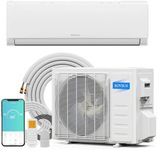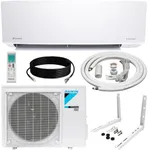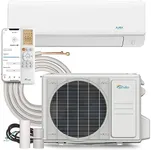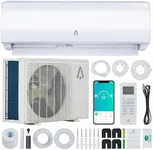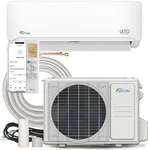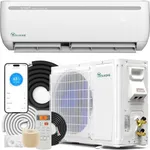Buying Guide for the Best Mini Split Units
Choosing the right mini-split unit for your home or office can significantly impact your comfort and energy efficiency. Mini-split units are a great option for heating and cooling individual rooms or zones without the need for extensive ductwork. To make an informed decision, it's important to understand the key specifications and how they relate to your specific needs. Here are the main factors to consider when selecting a mini-split unit.BTU CapacityBTU (British Thermal Unit) capacity measures the amount of heat a unit can remove from a room per hour. This spec is crucial because it determines the unit's ability to effectively heat or cool a space. Units with too low BTU capacity will struggle to maintain the desired temperature, while units with too high BTU capacity will cycle on and off too frequently, leading to inefficiency and wear. To choose the right BTU capacity, consider the size of the room or area you want to condition. For small rooms (up to 300 sq. ft.), a unit with 9,000 BTUs may suffice. Medium rooms (300-500 sq. ft.) typically require 12,000 BTUs, while larger rooms (500-800 sq. ft.) may need 18,000 BTUs or more.
SEER RatingThe SEER (Seasonal Energy Efficiency Ratio) rating measures the efficiency of the mini-split unit over a typical cooling season. A higher SEER rating indicates better energy efficiency, which can lead to lower electricity bills. SEER ratings typically range from 13 to 25 or higher. For moderate climates, a SEER rating of 16-18 is usually sufficient. In hotter climates, a higher SEER rating (20+) can provide better energy savings. Consider your local climate and how often you'll be using the unit to determine the appropriate SEER rating for your needs.
HSPF RatingHSPF (Heating Seasonal Performance Factor) rating measures the efficiency of the mini-split unit during the heating season. Similar to SEER, a higher HSPF rating indicates better efficiency. HSPF ratings typically range from 8 to 13. If you live in a colder climate and plan to use the unit for heating, look for a higher HSPF rating (10+). For milder climates, an HSPF rating of 8-9 may be adequate. Your heating needs and local climate will guide you in selecting the right HSPF rating.
Number of ZonesMini-split units can be designed to serve multiple zones or rooms. This spec is important if you want to control the temperature in different areas independently. Single-zone units are ideal for conditioning one room, while multi-zone units can handle two or more rooms. Consider the layout of your space and how many areas you need to heat or cool. If you have an open floor plan or only need to condition one room, a single-zone unit may be sufficient. For homes with multiple rooms or floors, a multi-zone unit can provide more flexibility and comfort.
Noise LevelThe noise level of a mini-split unit is measured in decibels (dB) and indicates how loud the unit will be during operation. This spec is important for maintaining a comfortable and quiet environment, especially in bedrooms or living areas. Noise levels typically range from 19 dB (very quiet) to 60 dB (comparable to normal conversation). If noise is a concern, look for units with lower dB ratings. For bedrooms and quiet spaces, aim for a unit with a noise level below 30 dB. For living areas, a noise level below 40 dB is generally acceptable.
Installation and MaintenanceProper installation and regular maintenance are crucial for the efficient operation and longevity of your mini-split unit. This spec includes the ease of installation, the availability of professional installation services, and the maintenance requirements. Some units come with DIY installation kits, while others may require professional installation. Consider your comfort level with installation and whether you prefer to hire a professional. Additionally, check the maintenance requirements, such as filter cleaning and refrigerant checks, to ensure you can keep the unit running smoothly.
